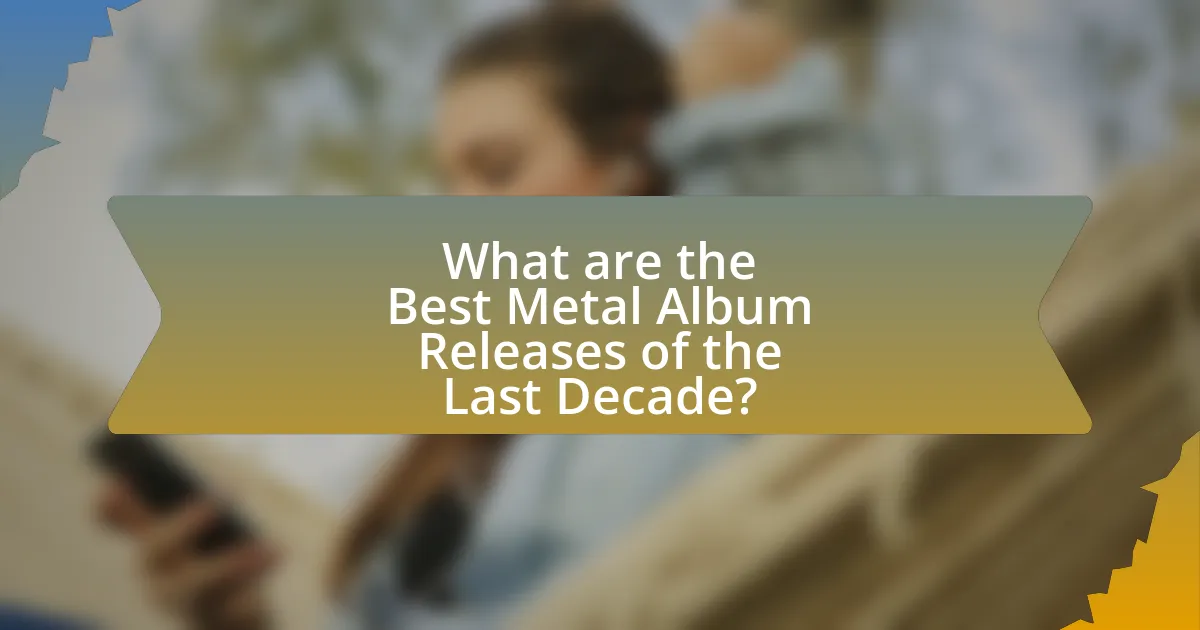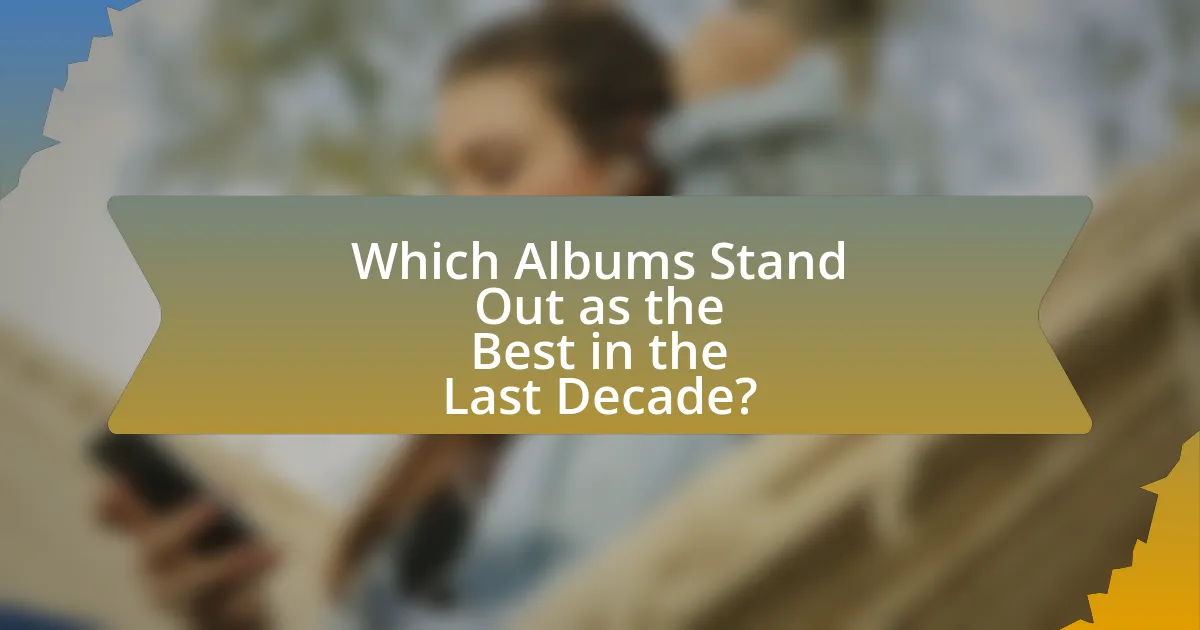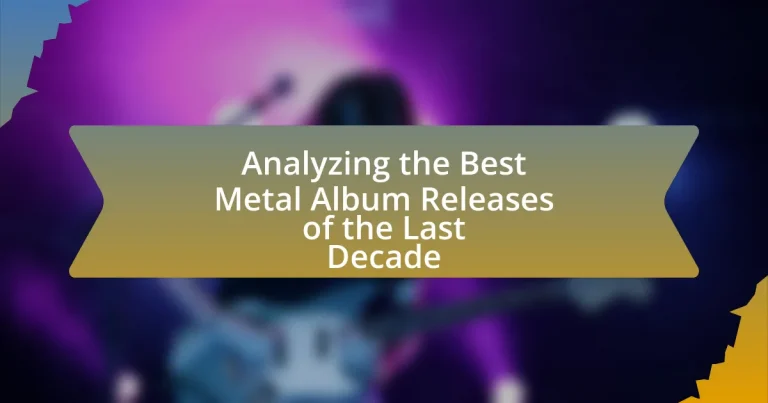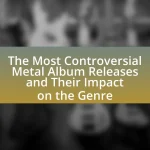The article analyzes the best metal album releases of the last decade, highlighting key albums such as “Magma” by Gojira, “The Stage” by Avenged Sevenfold, and “Fear Inoculum” by Tool. It defines the criteria for determining the “best” albums, including critical acclaim, commercial success, and influence within the genre. The article also explores the evolution of metal sub-genres, the impact of technology on production, and the thematic content of recent lyrics, while discussing how these elements have shaped the current metal scene and influenced emerging artists. Additionally, it examines marketing strategies and fan engagement practices that support metal artists today.

What are the Best Metal Album Releases of the Last Decade?
The best metal album releases of the last decade include “Magma” by Gojira, “The Stage” by Avenged Sevenfold, and “Fear Inoculum” by Tool. “Magma,” released in 2016, received critical acclaim for its innovative sound and emotional depth, earning a Grammy nomination for Best Metal Performance. “The Stage,” released in 2016, showcased Avenged Sevenfold’s musical evolution and was praised for its complex compositions and lyrical themes. “Fear Inoculum,” released in 2019, marked Tool’s return after a 13-year hiatus and debuted at number one on the Billboard 200, highlighting its significant impact on the genre. These albums exemplify the diversity and creativity present in modern metal music.
How do we define “best” in the context of metal albums?
The “best” in the context of metal albums is defined by a combination of critical acclaim, commercial success, and influence within the genre. Critical acclaim is often measured through reviews from reputable music publications, where albums that receive high ratings are considered exemplary. Commercial success can be quantified by album sales, chart positions, and streaming numbers, indicating widespread popularity. Influence is assessed by the album’s impact on other artists and its role in shaping the direction of metal music, often reflected in its adoption of innovative techniques or themes. For instance, albums like “Master of Puppets” by Metallica are frequently cited as benchmarks due to their lasting legacy and significant contributions to the genre.
What criteria are used to evaluate metal albums?
The criteria used to evaluate metal albums include musical composition, lyrical content, production quality, originality, and emotional impact. Musical composition assesses the complexity and creativity of the riffs, solos, and arrangements, while lyrical content examines the themes and storytelling within the songs. Production quality evaluates the clarity and balance of the sound, which is crucial in metal music. Originality considers how the album stands out within the genre and contributes to its evolution. Emotional impact measures the ability of the music to resonate with listeners, often reflected in reviews and fan reactions. These criteria are commonly referenced in music reviews and critiques, such as those found in publications like Metal Hammer and Decibel Magazine, which provide detailed analyses based on these factors.
How do critical reviews influence the perception of metal albums?
Critical reviews significantly shape the perception of metal albums by providing authoritative evaluations that can enhance or diminish an album’s reputation. For instance, a positive review from a respected publication can lead to increased sales and a larger fanbase, as seen with albums like “Magma” by Gojira, which received widespread acclaim and subsequently gained a broader audience. Conversely, negative reviews can deter listeners, as evidenced by the backlash faced by certain albums that received poor ratings from influential critics, impacting their commercial success and cultural standing. Thus, critical reviews serve as a crucial filter through which audiences assess the quality and relevance of metal albums.
What genres within metal have seen significant releases in the last decade?
In the last decade, genres within metal that have seen significant releases include progressive metal, death metal, black metal, and metalcore. Progressive metal has gained traction with albums like “The Simulation” by Haken and “Apex” by The Contortionist, showcasing complex compositions and musicianship. Death metal has continued to evolve, with notable releases such as “Obsolescence” by Rivers of Nihil and “Deceiver” by Blood Incantation, pushing the boundaries of the genre. Black metal has seen a resurgence with albums like “M” by MGLA and “The Wild Hunt” by Watain, blending traditional elements with modern influences. Metalcore has also remained prominent, highlighted by releases like “Misery” by Wage War and “All Our Gods Have Abandoned Us” by Architects, which combine melodic elements with heavy breakdowns. These genres reflect the dynamic nature of metal and its ability to innovate and resonate with audiences.
How has the evolution of sub-genres impacted album releases?
The evolution of sub-genres has significantly impacted album releases by allowing artists to target niche audiences and experiment with diverse musical styles. As sub-genres like metalcore, deathcore, and black metal have emerged, they have influenced the production and marketing strategies of albums, leading to more specialized releases that cater to specific fan bases. For instance, the rise of metalcore in the early 2000s resulted in bands like Killswitch Engage and As I Lay Dying achieving commercial success by blending melodic elements with hardcore influences, thus expanding their reach. This trend has been supported by data showing that albums categorized under specific sub-genres often perform better on streaming platforms, as listeners seek out tailored content that resonates with their preferences.
What role do emerging artists play in the current metal scene?
Emerging artists play a crucial role in the current metal scene by introducing innovative sounds and diverse influences that challenge traditional genre boundaries. These artists often bring fresh perspectives and experimentation, which can lead to the evolution of metal subgenres and the revitalization of the overall scene. For instance, bands like Spiritbox and Code Orange have gained significant attention for blending metal with elements of post-hardcore and electronic music, showcasing the genre’s adaptability. Their success reflects a growing trend where new artists leverage digital platforms for distribution, allowing them to reach wider audiences and contribute to the genre’s growth. This dynamic not only fosters a vibrant community but also encourages established artists to collaborate and engage with new talent, further enriching the metal landscape.
What are some notable trends in metal album releases over the last decade?
Notable trends in metal album releases over the last decade include an increase in genre fusion, with bands blending elements from various styles such as progressive, electronic, and even pop. This trend is evidenced by albums like “Magma” by Gojira, which incorporates atmospheric elements, and “Dissociation” by The Dillinger Escape Plan, which features diverse influences. Additionally, there has been a rise in the use of digital platforms for distribution, leading to a surge in independent releases; for instance, Bandcamp has become a popular choice for many artists to reach audiences directly. Furthermore, the resurgence of vinyl has been significant, with sales of vinyl records reaching a 30-year high in 2020, reflecting a growing appreciation for physical formats among metal fans.
How has technology influenced the production of metal albums?
Technology has significantly influenced the production of metal albums by enabling advanced recording techniques and digital tools that enhance sound quality and creativity. The introduction of digital audio workstations (DAWs) allows producers to manipulate sound with precision, facilitating complex arrangements and layering that were previously difficult to achieve. For instance, the use of plugins and virtual instruments has expanded the sonic palette available to metal musicians, enabling them to experiment with various styles and effects. Additionally, advancements in home recording technology have democratized music production, allowing independent artists to produce high-quality albums without the need for expensive studio time. This shift is evidenced by the rise of successful self-produced metal albums, such as “The Valley” by Whitechapel, which showcases intricate production techniques made possible by modern technology.
What themes and concepts have emerged in recent metal lyrics?
Recent metal lyrics have prominently featured themes of mental health, social justice, and existentialism. Mental health issues, such as anxiety and depression, are increasingly addressed, reflecting a broader societal conversation about these topics. Social justice themes, including critiques of systemic oppression and inequality, have gained traction, as seen in the works of bands like Spiritbox and Architects. Existentialism, exploring the meaning of life and human experience, is also prevalent, with bands like Gojira delving into environmental concerns and humanity’s impact on the planet. These themes resonate with listeners, providing both a reflection of contemporary issues and a means of catharsis.

Which Albums Stand Out as the Best in the Last Decade?
The albums that stand out as the best in the last decade include “Fear Inoculum” by Tool, “The Stage” by Avenged Sevenfold, and “Magma” by Gojira. “Fear Inoculum,” released in 2019, received critical acclaim for its complex compositions and innovative sound, marking Tool’s return after a 13-year hiatus. “The Stage,” released in 2016, showcased Avenged Sevenfold’s evolution with its ambitious themes and musical diversity, earning a Grammy nomination. Gojira’s “Magma,” released in 2016, was praised for its emotional depth and technical prowess, solidifying the band’s status in the metal genre. These albums have not only topped charts but also influenced the metal scene significantly, as evidenced by their reception and impact on listeners and critics alike.
What are the top-rated metal albums from 2013 to 2023?
The top-rated metal albums from 2013 to 2023 include “Magma” by Gojira, “The Satanist” by Behemoth, “Doom” by TesseracT, “Apex Predator – Easy Meat” by Napalm Death, and “Fear Inoculum” by Tool. These albums received critical acclaim and high ratings from various music publications and platforms, such as Metacritic and Pitchfork, reflecting their impact and popularity within the metal genre during this period. For instance, “Magma” was praised for its innovative sound and emotional depth, while “The Satanist” was noted for its raw intensity and lyrical themes.
Which albums received the highest critical acclaim?
The albums that received the highest critical acclaim in the last decade include “To Pimp a Butterfly” by Kendrick Lamar, “A Moon Shaped Pool” by Radiohead, and “Blackstar” by David Bowie. These albums consistently appear at the top of year-end lists and have garnered high scores from major music publications. For instance, “To Pimp a Butterfly” holds a Metacritic score of 96, indicating universal acclaim, while “Blackstar” received similar recognition with a score of 91. Such ratings reflect the albums’ innovative approaches and profound lyrical content, solidifying their status in critical discussions.
What fan-favorite albums have gained popularity over the years?
Fan-favorite albums that have gained popularity over the years include “Magma” by Gojira, “The Stage” by Avenged Sevenfold, and “Doomed User” by Deftones. “Magma,” released in 2016, received critical acclaim and has been recognized for its innovative sound, leading to increased fan engagement and streaming numbers. “The Stage,” released in 2016, marked a significant return for Avenged Sevenfold, with its complex compositions resonating with both old and new fans, resulting in a resurgence in popularity. Deftones’ “Gore,” released in 2016, has also seen a steady rise in appreciation, particularly for its atmospheric soundscapes, contributing to its lasting impact in the metal community. These albums exemplify how quality and innovation can lead to sustained popularity over time.
How do these albums compare to previous decades?
The albums released in the last decade showcase a significant evolution in metal compared to previous decades, characterized by increased genre blending and technological advancements in production. For instance, the integration of electronic elements and diverse influences from genres like hip-hop and pop has become more prevalent, as seen in albums like “Magma” by Gojira and “The Stage” by Avenged Sevenfold. Additionally, the accessibility of digital platforms has allowed for a broader range of artists to emerge, leading to a more diverse metal scene than in the 1980s and 1990s, when traditional subgenres dominated. This shift is evidenced by the rise of bands like Spiritbox and their innovative sound, which contrasts sharply with the more formulaic approaches of earlier decades.
What are the defining characteristics of the best albums from the last decade?
The defining characteristics of the best albums from the last decade include innovative soundscapes, lyrical depth, and strong emotional resonance. Innovative soundscapes are evident in albums that blend genres, such as the incorporation of electronic elements in metal, which has expanded the genre’s boundaries. Lyrical depth is showcased through complex themes and storytelling, often addressing personal and societal issues, as seen in albums like “Fear Inoculum” by Tool, which explores existential themes. Strong emotional resonance is reflected in the ability of these albums to connect with listeners on a personal level, often eliciting powerful responses, as demonstrated by the widespread acclaim for “Apex Predator – Easy Meat” by Napalm Death, which critiques modern society. These characteristics collectively contribute to the critical and commercial success of the best albums in the metal genre over the past decade.
How have classic bands adapted their sound in recent releases?
Classic bands have adapted their sound in recent releases by incorporating modern production techniques and diverse musical influences. For instance, bands like Metallica have experimented with orchestral elements in their album “S&M2,” blending heavy metal with symphonic arrangements, which showcases their willingness to evolve while maintaining their core identity. Similarly, Iron Maiden’s “Senjutsu” features progressive song structures and varied instrumentation, reflecting contemporary trends while staying true to their classic sound. These adaptations demonstrate how classic bands are innovating to remain relevant in today’s music landscape while appealing to both long-time fans and new listeners.
What impact have these albums had on the metal community?
These albums have significantly influenced the metal community by pushing musical boundaries and inspiring new subgenres. For instance, the incorporation of diverse elements such as orchestral arrangements and electronic influences in albums like “Magma” by Gojira and “The Stage” by Avenged Sevenfold has led to a broader acceptance of experimentation within the genre. Additionally, the lyrical themes addressing social issues and personal struggles in albums like “Atonement” by Parkway Drive have resonated deeply with fans, fostering a sense of community and dialogue. The commercial success of these albums, evidenced by chart placements and sales figures, has also validated the evolving landscape of metal, encouraging both established and emerging artists to explore innovative sounds.
How have these albums influenced new artists and bands?
These albums have significantly influenced new artists and bands by setting high standards for musical complexity and production quality. For instance, the intricate guitar work and innovative songwriting found in albums like “Magma” by Gojira and “The Stage” by Avenged Sevenfold have inspired emerging musicians to push their creative boundaries. Additionally, the thematic depth and emotional resonance present in these works encourage new artists to explore more profound lyrical content, as seen in the rise of bands like Spiritbox and their introspective approach. This influence is evident in the increasing number of new metal acts that incorporate diverse genres and experimental elements, reflecting the legacy of these landmark albums.
What role do live performances play in promoting these albums?
Live performances significantly enhance the promotion of metal albums by creating direct engagement between artists and fans. These events allow musicians to showcase their new material, generating excitement and word-of-mouth promotion that can lead to increased album sales. For instance, a study by the International Journal of Music Business Research found that artists who tour extensively see a 30% increase in album sales compared to those who do not perform live. Additionally, live performances often lead to greater visibility through social media sharing and media coverage, further amplifying the reach of the album.

What Insights Can We Gain from Analyzing These Releases?
Analyzing the best metal album releases of the last decade provides insights into evolving musical trends, thematic content, and audience preferences within the genre. By examining these releases, one can identify shifts in production techniques, the incorporation of diverse musical influences, and the emergence of new sub-genres. For instance, the rise of progressive metal and the blending of metal with electronic elements reflect a broader trend towards experimentation in sound. Additionally, lyrical themes often address contemporary social issues, showcasing how artists respond to cultural contexts. This analysis reveals not only the artistic direction of metal music but also its resonance with listeners, as evidenced by chart performance and critical acclaim.
What lessons can be learned from the success of these albums?
The success of these albums demonstrates the importance of innovation and authenticity in metal music. Albums that incorporate unique sounds, such as blending genres or experimenting with production techniques, tend to resonate more with audiences. For instance, the album “Magma” by Gojira, which integrates elements of progressive metal and tribal rhythms, received critical acclaim and commercial success, highlighting how creativity can set an album apart. Additionally, strong lyrical themes that connect with listeners on a personal or societal level, as seen in “The Stage” by Avenged Sevenfold, can enhance an album’s impact. This indicates that meaningful content, combined with musical experimentation, is crucial for achieving success in the metal genre.
How can upcoming artists apply these lessons to their work?
Upcoming artists can apply the lessons from analyzing the best metal album releases of the last decade by studying the successful elements of songwriting, production, and audience engagement found in those albums. For instance, many acclaimed metal albums feature intricate guitar work, dynamic song structures, and powerful lyrical themes that resonate with listeners. By incorporating these elements into their own music, upcoming artists can enhance their creative output and connect more effectively with their audience. Additionally, understanding the marketing strategies used by successful metal bands, such as social media engagement and live performances, can help new artists build their brand and reach a wider audience.
What marketing strategies have proven effective for metal albums?
Effective marketing strategies for metal albums include leveraging social media platforms, engaging with fan communities, and utilizing targeted advertising. Social media, particularly platforms like Instagram and Facebook, allows artists to share content directly with fans, fostering a sense of community and loyalty. Engaging with fan communities through forums and dedicated websites helps build a dedicated listener base, while targeted advertising on platforms like Spotify and YouTube can reach specific demographics interested in metal music. According to a 2021 study by the International Journal of Music Business Research, 70% of successful metal album launches utilized social media campaigns to enhance visibility and engagement, demonstrating the effectiveness of these strategies.
How can fans engage with the music and artists more deeply?
Fans can engage with music and artists more deeply by participating in live events, such as concerts and meet-and-greets, which foster personal connections. Engaging in discussions on social media platforms allows fans to share their interpretations and experiences related to the music, creating a community around the artist. Additionally, purchasing merchandise and supporting crowdfunding campaigns for albums or tours directly contributes to the artist’s success and strengthens the fan-artist relationship. Research indicates that fans who actively participate in these activities report a greater sense of belonging and connection to the music and artists they admire.
What are the best ways to support metal artists today?
The best ways to support metal artists today include purchasing their music directly, attending live shows, and engaging with them on social media platforms. Purchasing music through platforms like Bandcamp allows artists to receive a larger share of the revenue compared to streaming services. Attending live shows not only provides financial support but also helps to build a community around the genre, as live performances are crucial for artists’ income. Engaging with artists on social media fosters a direct connection, allowing fans to share their work and promote upcoming releases, which can significantly enhance visibility and reach.
How can fans participate in the metal community surrounding these albums?
Fans can participate in the metal community surrounding these albums by engaging in discussions on social media platforms, attending live shows, and joining online forums dedicated to metal music. Social media platforms like Facebook and Twitter host numerous groups where fans can share their thoughts on recent releases, connect with other enthusiasts, and discuss album reviews. Attending live shows not only allows fans to experience the music firsthand but also fosters a sense of community among attendees. Additionally, online forums such as Reddit’s r/Metal provide spaces for fans to exchange opinions, share playlists, and discover new bands, thereby enhancing their involvement in the metal scene.
What are the best practices for discovering new metal music?
To discover new metal music effectively, utilize online platforms like Spotify and Bandcamp, which offer personalized recommendations based on listening habits. Engaging with metal communities on social media platforms such as Reddit and Facebook can also provide insights into emerging bands and albums. Additionally, following music blogs and websites dedicated to metal, like Metal Injection and Blabbermouth, ensures access to reviews and news about new releases. Attending live shows and festivals allows for firsthand exposure to new artists, while streaming services often curate playlists that highlight recent metal releases, making it easier to explore new sounds.


